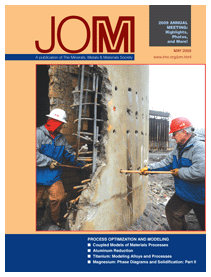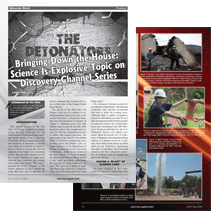 LATEST ISSUE |
||||
TMS QUICK LINKS: |
• TECHNICAL QUESTIONS • NEWS ROOM • ABOUT TMS • SITE MAP • CONTACT US |
JOM QUICK LINKS: |
• COVER GALLERY • CLASSIFIED ADS • SUBJECT INDEXES • AUTHORS KIT • ADVERTISE |
|
| Materials World: Feature | Vol. 61, No.5 pp. 15-18 |
Bringing Down the House: Science is Explosive
Topic on Discovery Channel Series
Lynne Robinson
Questions? Contact jom@tms.org. |
|
The skeletal remains of the Tule Lake Lift Bridge wobbled uncertainly against the gray Texas sky. For the small huddle of hard-hatted men watching tensely nearby, it was a very long 50 seconds. Weeks of painstaking work and hundreds of thousands of dollars were riding on a network of small explosives timed to strategically slice the supports of the bridge’s two remaining towers. The intended outcome was for
the 15-story structures to topple away
from the busy waterway and crumple
onto a target area of land. “Oh, c’mon,”
groaned one of the “blasters” as the
towers appeared to lurch toward the
water. But then, just as planned, the
towers collapsed into twisted steel ruins
on both sides of the Corpus Christi
Inner Harbor. The
opportunity to get viewers “beyond the
boom” of explosives engineering was a
primary reason that Braden Lusk, assistant
professor in the Department of
Mining Engineering at the University
of Kentucky, signed on as co-host of
the show (Figure 2). “A lot of people
are interested in blowing things up, but
a very small percentage understands
the necessity for using explosives,” he
said. “This gave us a chance to highlight
that using explosives is often the
safest and most economical way to get
things done.” According to the 2007 Minerals Yearbook published by the U.S. Geological Survey, coal mining consumes about 66 percent of U.S explosives, with quarry and nonmetal mining coming in a distant second at 12 percent, and metal mining taking up about eight percent. Explosives engineering also plays an important role in research related to the blast mitigation properties of materials used in construction and in the military. For those intrigued by this wider world of explosives engineering, Paul Worsey, the second half of The Detonators hosting team and professor in the Department of Mining Engineering at Missouri University of Science and Technology (MST), has created a “smorgasbord” of explosive experiences at his wildly popular Summer Explosives Camps. Geared to high school
students who have an interest or aptitude
in engineering, the camps offer six
days of pyrotechnic learning that balance
lectures with memorable handson
activities, such as igniting a “wall
of fire” (Figures 3–5). Students also
take field trips to mining and blasting
operations and treat their parents to a
fireworks display of their own creation
on the last night. Giving these bright teenagers a real
eyeful (and earful) of the fun of engineering
seems to be working. Since
the program’s inception, approximately
2/3 of the campers have enrolled
at MST. More than 25 percent of the
current freshman class in MST’s Mining
Engineering program attended Explosives
Camp, while the majority of
campers enrolling in other departments
have opted for explosives engineering
minors, an opportunity unique to MST.
“In fishing terms, it has been the ‘chartreuse lure’ for the mining engineering
program,” Worsey said. GETTING THE SCIENCE RIGHT
While The Detonators doesn’t offer
the Explosives Camp’s range of experiences,
Worsey employs the same
hands-on teaching approach to help
viewers understand the science behind
the big bangs. Each episode’s main demolition
story is paired with a segment
in the MST blasting research lab where
Lusk and Worsey present the right and
wrong way to address that particular
project’s engineering problem.
A key component
of the shaped charge is a Vshaped
liner made of a dense, ductile
metal, such as copper. The liner is surrounded
with an explosive that, when
detonated, squeezes the metal together
to form a blade, while also forcing it
through the steel at five times the speed
of sound. Since the blade can generally
only cut its own length, the steel has to
be weakened with strategic cutting so
it fails on cue. Collapsing too early or
too late could mean the structure is left
standing, or worse yet, could fall in the
wrong place. “It’s like a big game of
Jenga,” said Worsey. “You keep pulling
pieces out without the structure falling down until you need it to.”
A second column is then wrapped in a cocoon of chain link and
geotechnical fabric, a synthetic fiber
textile commonly used to construct
roads and reinforce embankments. The
fabric and metal together smother the
debris of the subsequent blast, with
just a few stones spewing out of the top
of the mummified column. “I thought
this really demonstrated what is done
to protect the property near a blasting
zone,” said Lusk.
Although all the stories on The Detonators end basically the same way, there are moments when things don’t
go exactly according to script. When
a hotel in Florida is imploded, for instance,
the steel structure falls away,
but the concrete core stands stubbornly
intact. Showing this side of
science—and how the professionals
involved deal with it—is a good thing,
according to Lusk. “I think people get
the impression that this type of work is
easy, because you rarely see something
go wrong,” he said. “What makes you
effective at your job is how well you
manage those unexpected issues.” “That’s when you
determine how strong the concrete is
or if there are steel I-beams in the middle
of a concrete column. You make
decisions depending on the strength
and, in the case of steel, the physical
dimensions of the building materials.”
The blasting plan can become quite
problematic, Lusk said, when buildings
have more than one kind of construction
technique or when steel and
concrete are combined. Lynne Robinson is the news writer for Materials Technology@TMS.
|










